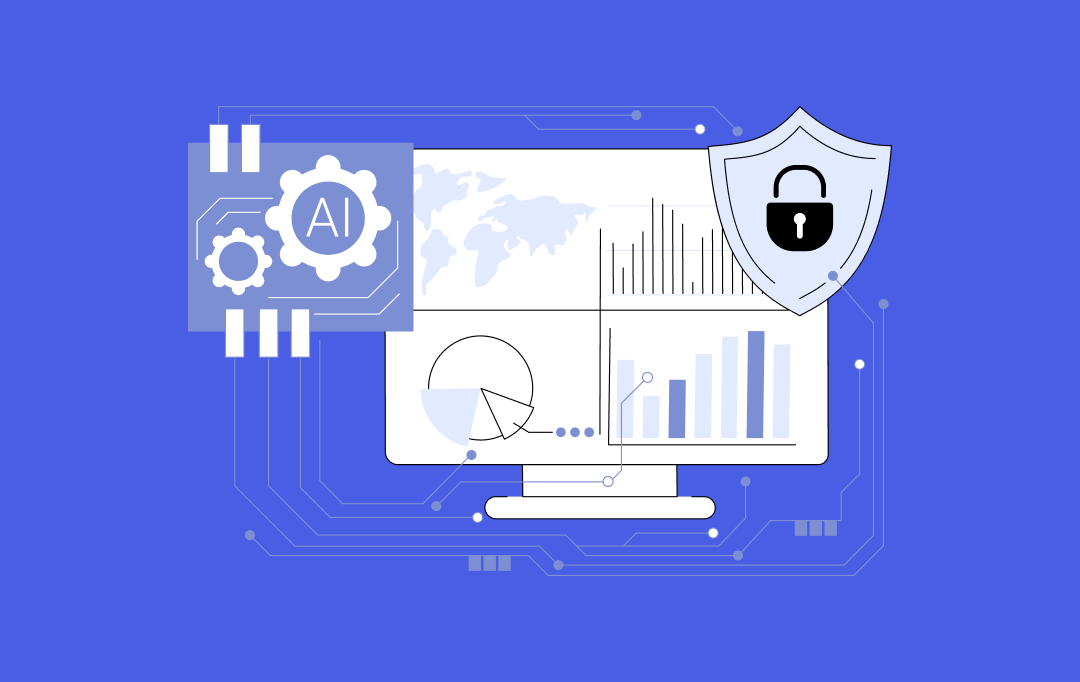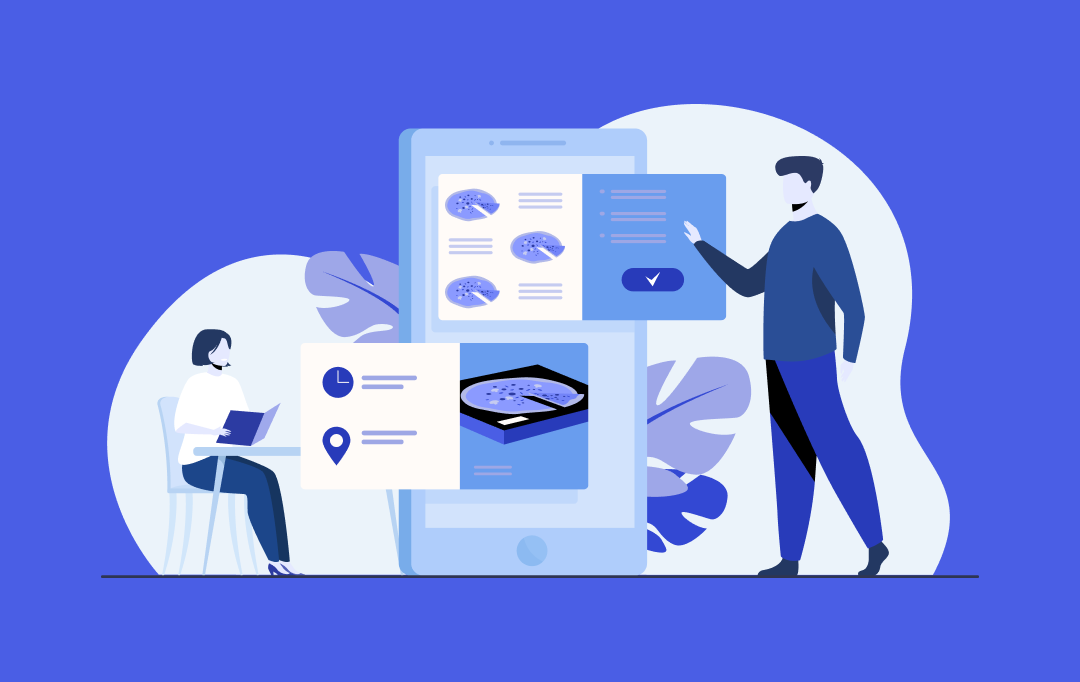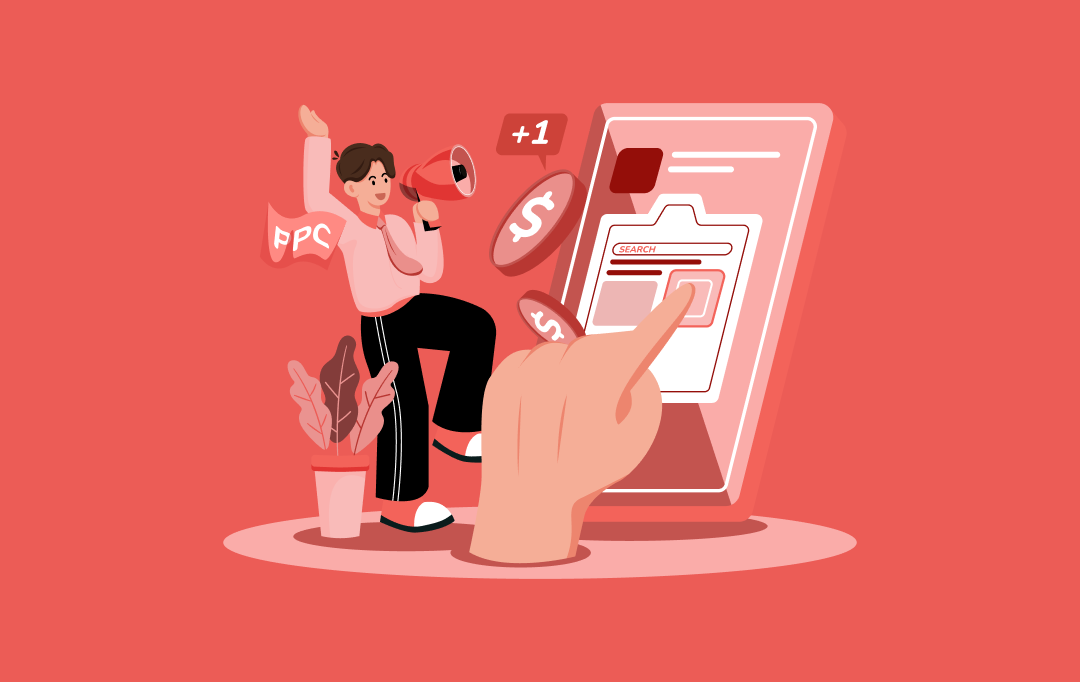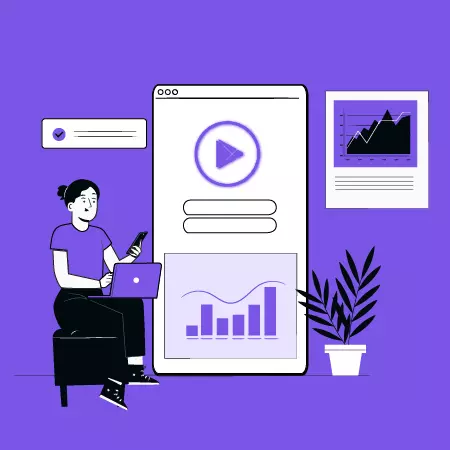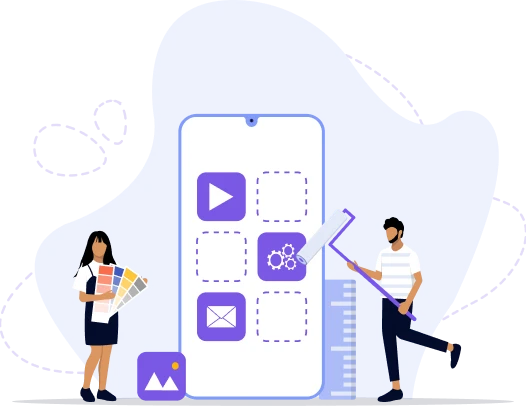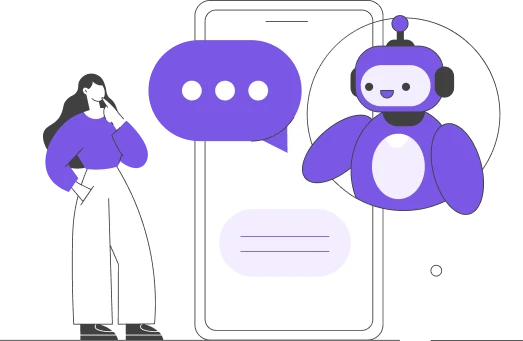- Market Reality Check: Understanding Today's Google Play Store Competition
- Key Google Play Store Statistics in 2025
- 1. Total Number of Apps on Google Play Store
- 2. Total Number of Apps Released Per Week and Month
- 3. Mobile App Downloads Expected by 2026
- 4. Total Number of Apps With 4 or Above Ratings
- 5. Estimated Spending on the Google Play Store
- 6. Price Distribution
- 7. Free and Paid Android Apps
- 8. Advanced Monetization Strategies on Google Play
- 9. Global Users of Play Store Apps
- 10. Leading Android Apps in the Google Play Store
- Google Play vs. Apple App Store
- Google Play Store Trends 2025 and Beyond: What’s Shaping the Next Generation of Apps
- AI-Powered Personalization
- 5G, 6G, and Edge Computing Integration
- Stronger Focus on Privacy and Security
- Cross-Platform and Multi-Device Compatibility
- Leveraging AI to Boost App Discoverability and User Engagement on Google Play
- Why Appinventiv is the Right Partner for Your Android App Development Journey
- FAQs
- Google Play Store Landscape – After stricter quality controls, the store hosts ~1.58M active apps, with 1,200+ new apps launching daily.
- Monetization Shift – 97% of apps are free, and 98% of revenue comes from ads and in-app purchases, proving the dominance of the freemium model.
- App Quality & Ratings – By June 2025, only ~234K apps achieved 4.0+ star ratings, highlighting the importance of delivering exceptional UX and positive reviews.
- Future Trends Driving Success – AI personalization, 5G/6G, and stronger privacy standards will shape app discoverability, engagement, and long-term business advantage.
The mobile app economy has transformed into the primary battleground for customer acquisition and revenue generation, with the Google Play Store commanding access to over 2.5 billion active users globally. The Google Play apps market represents the largest mobile ecosystem worldwide, yet you’re probably underestimating its strategic significance in your business’ digital transformation initiatives.
Google Play Store stats reveal something critical for your business: platform algorithm modifications, evolving monetization frameworks, and shifting user engagement patterns now determine which organizations achieve sustainable competitive advantages versus those that hemorrhage marketing capital without measurable returns.
Here’s the reality you’re facing – you can no longer approach mobile app development as just another marketing channel. The strategic choice in front of you is crystal clear:
- Master the Play Store ecosystem – Systematically leverage platform-specific features to build competitive advantages that actually stick for your business
- Accelerate market expansion – Turn Play Store insights into measurable business growth that your competitors are missing
Google Play business insights 2025 show us that the companies winning right now are those using data-driven app store strategies, while others are still throwing money at outdated approaches. If you’re serious about building that million-dollar business model, you need to understand exactly where the opportunities are.
2.5 Billion Active Users, One Opportunity – Stand out in the crowded Google Play Store. Let’s develop your app for success.
Market Reality Check: Understanding Today’s Google Play Store Competition
The statistics below give you the concrete data you need to make smart decisions about your mobile app investments and how to allocate your resources for maximum impact.
The Google Play Store represents the ultimate digital battleground where approximately 1.58 million apps were available as of Sept 2025, competing for attention from mobile users worldwide. These compelling app download statistics demonstrate the massive scale of mobile user engagement that your business could potentially tap into.
However, that’s not the complete picture.
Google Play’s ecosystem continues expanding with 1.58 million active apps as of September 2025, while Google maintains platform quality through strategic curation—adding over 40,000 new apps while removing around 32,000 apps in August 2025, resulting in net growth of 8.25 thousand apps that demonstrates both opportunity and quality control.
What Google Now Removes:
- Static Apps: Text-only applications without interactive features
- Limited Content Apps: Those offering single wallpapers or minimal functionality
- “Do-Nothing” Apps: Applications designed with no actual purpose or function
- Low-Quality Content: Apps that provide little user value or engagement
Instead of only banning broken apps that crashed, wouldn’t install, or run properly, the company began banning apps that demonstrated “limited functionality and content,” including static apps without app-specific features, such as text-only apps or PDF-file apps.
Google has intensified its quality control standards throughout 2025. The platform now requires developers with personal accounts created after November 13, 2023, to complete rigorous testing protocols.
New Testing Requirements for Developers:
- Minimum Testers: At least 12 engaged testers must actively use their apps for 14 consecutive days before production access is granted
- Reduced from Previous: This represents a reduction from the previous requirement of 20 testers, according to the Testers Community
- Higher Engagement Standards: Simple app installations are no longer sufficient, Google requires consistent daily activity and meaningful feedback
- Real-World Testing: Developers must demonstrate genuine user engagement rather than superficial compliance
This creates significant pressure for Google Play app developers who must maintain exceptional quality and strictly adhere to evolving guidelines.
The Bottom Line: With fierce competition from over 1,249 new daily releases despite the reduced total app count, these essential Google Play Store statistics for 2025 focus on the metrics that actually matter for your business decisions. Understanding these key Google Play stats will help you make informed choices and determine your competitive positioning in this high-stakes digital ecosystem.
Also Read: How To Upload An App To Google Play Store?
Key Google Play Store Statistics in 2025
As 2025 moves forward, Google Play Store keeps its grip on the app market, showing off just how varied and fast-moving this whole ecosystem really is. The newest Google Play stats give businesses some pretty useful information about what it takes to make it on the platform. Here’s a look at some important Google Play Store stats that show what’s happening and how things are changing:
1. Total Number of Apps on Google Play Store
The first question businesses ask about Android apps is, “How many apps are on the Google Play Store?” Google Play was home to over 3.5 million Android apps initially. After Google’s big cleanup of subpar apps, that number has now come down to 1.58 million, as per Sept 2025. Thus, the current number of apps on Google Play Store really shows how Google is prioritizing quality over quantity these days. You’ve got everything from productivity apps and social networks to really niche tools—there’s basically something for whatever people are looking for. This variety makes the Google Play apps market tough to compete in, but it also creates tons of chances for the right developers.
About 1,249 new apps go live every single day, which adds up to roughly 41,000 fresh apps hitting the platform each month. The latest app download statistics really show just how cutthroat this growing marketplace has become. However, it’s not solely about new arrivals; Google has eliminated more than 2.6 million applications over the years, which reflects their dedication to upholding quality standards. These Google Play business insights 2025 illustrate a platform in constant flux, where applications are continuously being introduced and removed based on performance and compliance criteria.
2. Total Number of Apps Released Per Week and Month
According to the latest data from AppBrain, in August 2025 alone, Google Play saw the launch of over 40,000 new applications, demonstrating the platform’s continued robust developer activity despite stricter quality controls. Based on current Google Play app statistics, this considerable figure underscores the continued growth within the digital marketplace.
With all these new apps flooding in, getting ahead of your competition takes a lot more than just building something good. You really need solid marketing strategies too. Understanding app download statistics becomes essential for determining your competitive position and analyzing market dynamics effectively.
- Understand Google Play’s Algorithm: Optimize your application on the Play Store for enhanced visibility and improved ranking performance. Mastering Google Play Store ranking factors provides a strategic advantage in app discovery processes.
- Engage Users Effectively: Use strategies to keep users active and retain them.
- Align with Platform Trends: Utilize prevailing market trends to establish a competitive advantage within the growing application marketplace.
3. Mobile App Downloads Expected by 2026
By 2026, consumers are projected to download approximately 143 billion mobile apps from the Google Play Store. These impressive app download statistics signal unprecedented growth opportunities. For forward-thinking business leaders, this surge means the need to build exceptional apps.
For progressive business leaders, this growth indicates the necessity to not only develop outstanding enterprise-grade Android apps but also implement a strategic, analytics-based approach to user acquisition and retention.
- Prioritize App Quality: Deliver a flawless user experience that distinguishes your application from competitors.
- Leverage Data-Driven Insights: Utilize comprehensive analytics to enhance user acquisition and retention strategies. Deploying effective Google Play Store analytics enables monitoring of performance indicators and user engagement behaviors.
- Stay Agile: Respond rapidly to shifting market dynamics and evolving user preferences.
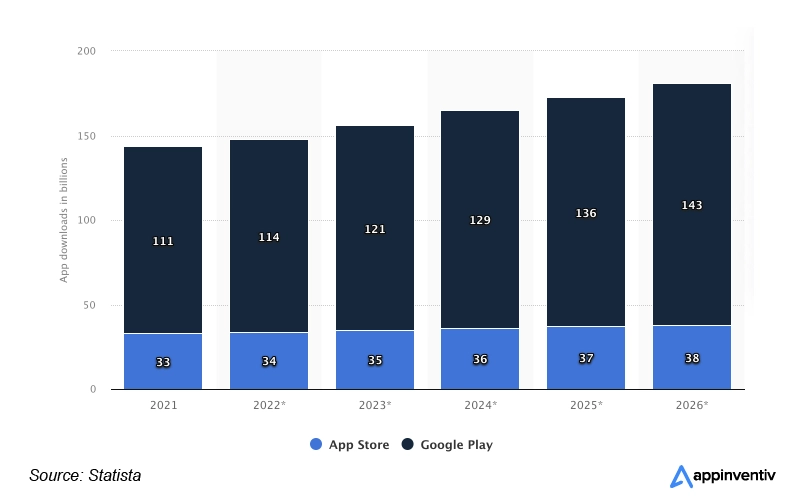
4. Total Number of Apps With 4 or Above Ratings
Approximately, more than 230,000 applications on Google Play Store achieved ratings of 4.0 stars or higher, while 109,473 applications reached the 4.5-star threshold or above. This distribution indicates that numerous applications successfully engage users sufficiently to generate feedback, yet a substantial portion requires additional ratings. This demonstrates the critical importance of encouraging user reviews, as they enhance both credibility and discoverability.
While many applications demonstrate strong performance through high ratings, the majority have not yet achieved the 4.0-star benchmark. For Google Play app developers and organizations, this presents a significant opportunity to enhance application quality and user experience.
- Room for Growth: Many applications remain below the 4.0-star rating, indicating considerable potential for improvement.
- Power of Ratings: Improving ratings can result in enhanced visibility, increased user confidence, and greater download volumes.
- Focus on Quality: Success depends on advancing both application performance and overall user experience.
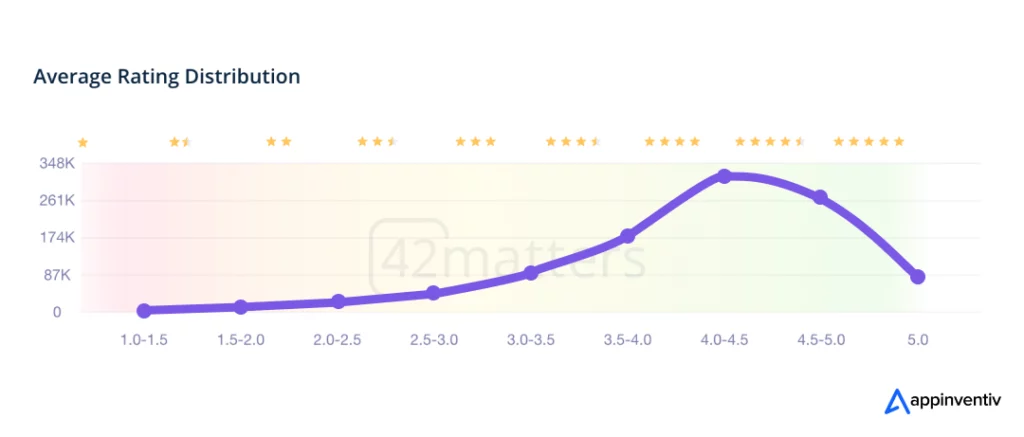
5. Estimated Spending on the Google Play Store
Google Play Store revenue stream continues its upward climb. The platform pulled in nearly $50 billion in 2023. With annual growth hovering around 10-12%, projections point toward $60-65 billion by the end of 2025.
Gaming dominates these figures, driving the bulk of user purchases through in-app transactions and subscriptions. This growth trend has sparked increased demand for mobile app development across the US market, as companies race to capitalize on expanding consumer digital spending.
The play store statistics indicate a fundamental shift occurring within the digital landscape, creating substantial business opportunities. Recent Google Play app statistics support this trend, demonstrating that users are investing unprecedented amounts of money and time in mobile applications.
- Mobile Apps Are Essential: Applications have transformed from basic entertainment tools into indispensable components of daily operations.
- Lucrative Opportunity: The escalating spending patterns provide developers with access to an expanding market segment.
- Dominant Revenue Stream: Mobile applications have transitioned from secondary considerations to primary drivers of business monetization strategies.
6. Price Distribution
The Google Play Store has some pretty striking numbers when it comes to pricing—97% of apps don’t cost anything upfront, which makes sense since most businesses are using that freemium approach. They attract people to the door for free, then generate revenue through ads or by encouraging users to make purchases within the app.
The remaining 3% of apps charge upfront, and their prices vary significantly depending on what they offer and who they target. You’ll find paid apps starting at just $0.49 and going all the way up to $400, which really depends on how complex the app is, what kind of users it’s intended for, and how the developer has decided to price it.
- $0.99: Common in casual games and utility apps.
- $1.99 to $4.99: Frequently seen in premium games and productivity tools.
- $5.00 and above: Typically for specialized apps, such as professional tools, educational software, and enterprise solutions.
- Balanced Pricing: Free apps attract users, while premium apps strategically monetize through features.
7. Free and Paid Android Apps
According to Statista, in January 2025, approximately 97% of Android apps were free, with the remaining 3% requiring payment. Throughout the period analyzed, the quantity of free apps on the Google Play Store consistently exceeded that of paid apps.
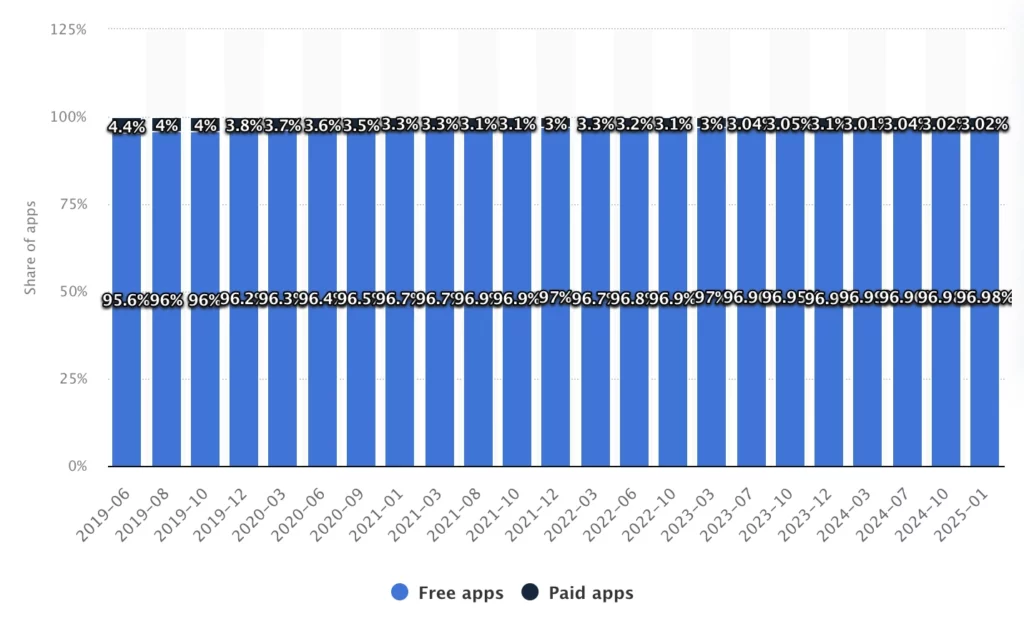
Well, it is vital to understand that most of the revenue earned by mobile apps comes from free apps with the help of app monetization strategies like in-app purchases, equivalent to 98% of app revenue worldwide. This overwhelming amount of free apps on the Play Store signifies a major shift towards the freemium model. These Google Play statistics are why people prefer developing Android apps.
8. Advanced Monetization Strategies on Google Play
In 2025, Google Play Store developers are increasingly adopting AI-driven personalization and dynamic subscription models to enhance user engagement and revenue. These strategies leverage user behavior data to offer tailored in-app purchases and subscription plans, optimizing the user experience and maximizing lifetime value. Additionally, contextual advertising is being utilized to display relevant ads without disrupting user experience, thereby improving ad performance and user satisfaction.
For instance, Google’s introduction of AI-enhanced subscription tiers, such as the $19.99/month Google One plan, has significantly boosted subscriber numbers, highlighting the effectiveness of AI in driving monetization. (Reuters)
9. Global Users of Play Store Apps
As of 2025, based on DemandSage data, there are a whopping 3.6 billion Android users across the globe, making up a massive 73.9% of the mobile operating system market. That’s a huge chunk! Even in the U.S., Android holds strong with a 42.51% share of the mobile OS market. However, it doesn’t stop there—Android 14 has already captured 24.51% of the Android version market share, demonstrating just how quickly users are adopting the latest updates.
And if we look at the Android mobile vendors, Samsung is still leading the pack, dominating the scene with a solid 22.91% market share. With such a large and loyal user base, it’s clear that Android is not just an operating system; it’s a global powerhouse in mobile technology. These Android app market trends 2025 demonstrate the platform’s continued dominance and growth potential.
10. Leading Android Apps in the Google Play Store
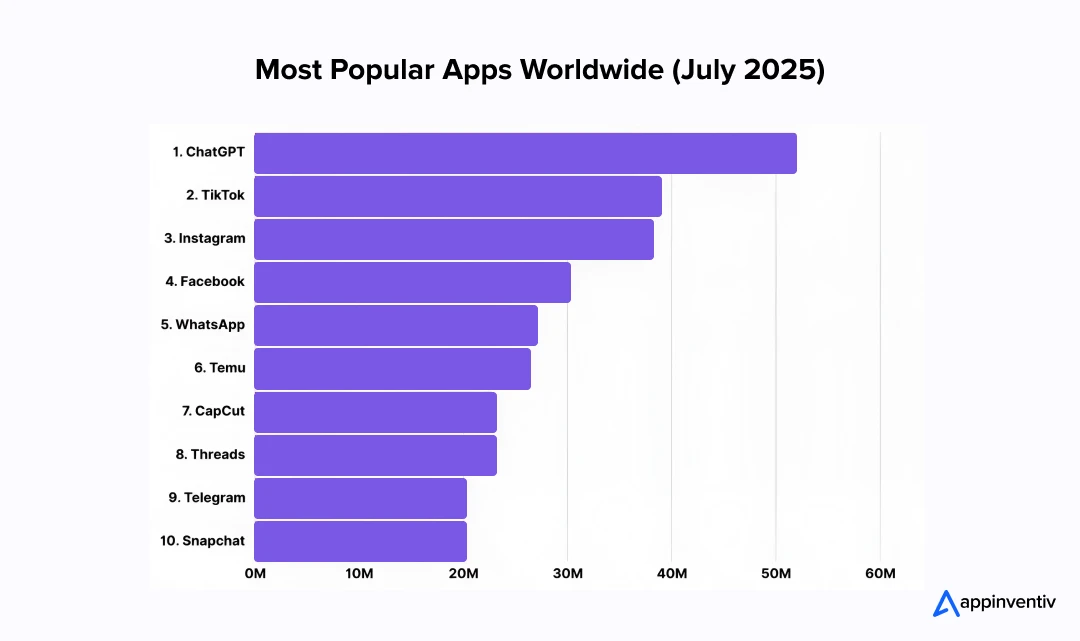
As of April 2025, ChatGPT took the lead as the most downloaded app globally, racking up an impressive 52 million downloads, solidifying its place as a major player in the AI space. This analysis of Google Play top apps reveals significant shifts in user preferences. Not far behind, TikTok and Instagram both captured the spotlight in the social app category.
On the shopping front, Temu emerged as the top contender, with 25 million downloads, reflecting the growing popularity of mobile shopping apps in today’s fast-paced, convenience-driven market. The performance of these Google Play top apps demonstrates the evolving digital commerce landscape.
These App Store statistics clearly demonstrate the huge download numbers and worldwide presence of these platforms, which make it evident that there are massive opportunities for businesses to connect with audiences that are growing and becoming more diverse.
All the Google Play stats we’ve examined indicate a platform that’s growing rapidly, with downloads, revenue, and user activity all increasing. They demonstrate just how much potential there is for businesses to refine their approach and achieve better visibility and profits on Android.
As the mobile app landscape continuously evolves, some businesses still wonder about the ongoing debate of Google Play Store vs App Store. After analyzing the Google Play Store stats, it is vital for companies also to understand the nuances of the iOS platform, especially if they aim to maximize their app’s reach and effectiveness. Let us delve deeper into this comparison and equip you with the insights to make informed decisions for your app development and marketing strategies.
Let’s dig into this comparison so you can make smarter choices about how to develop and market your apps.
With ChatGPT hitting 52M downloads and mobile commerce exploding, position your app for maximum visibility and revenue growth.
Google Play vs. Apple App Store
The whole Google Play versus Apple App Store thing goes way beyond just competition—it’s really about two completely different approaches to mobile, innovation, and what users actually want. Each one has its own advantages, whether that’s Android’s huge worldwide presence or Apple’s more exclusive, carefully managed setup.
Which one makes sense for you really comes down to who your audience is, how you plan to make money, and what your overall app strategy looks like, since both give you some pretty amazing chances in this mobile market that just keeps getting bigger.
Let’s break down the key differences between Google Play Store and the App Store so you can figure out what matters most for your app development and business plans:
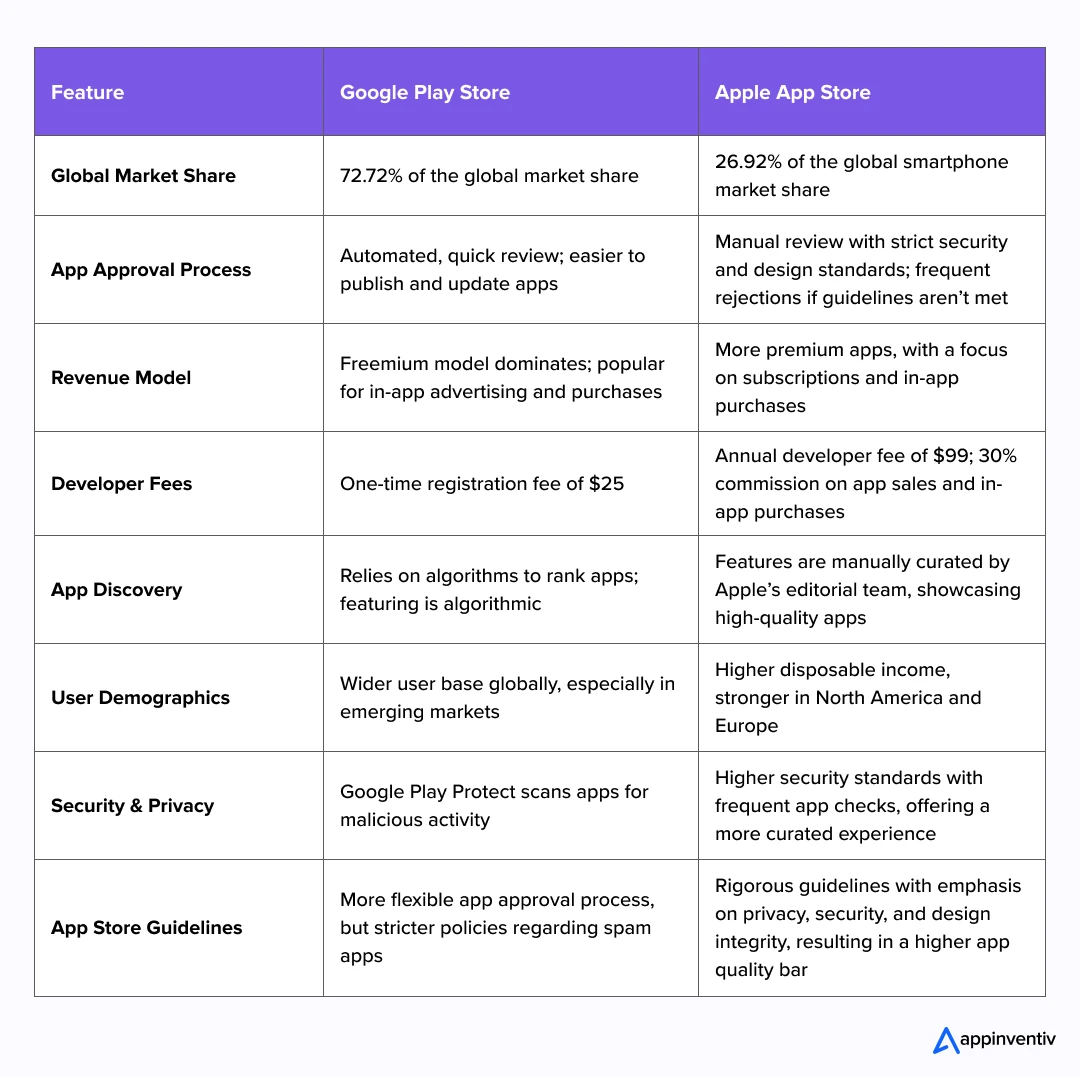
Finding the perfect platform for your business venture feels like navigating a maze, doesn’t it? Every entrepreneur faces this crossroads when diving into mobile app development. The choice between Android and iOS isn’t just about preference – it’s about understanding where your customers actually spend their time scrolling and tapping.
Successful mobile app ventures require strategic thinking beyond platform preference – here’s how to make data-driven decisions that convert:
Platform Selection:
- Analyze user behavior patterns and market dynamics instead of relying on assumptions
- Strategic platform decisions require deep understanding of Google Play user behavior stats and their implications.
- Research where your target audience spends their mobile time
- Match platform choice to real user data, not personal preferences
- Recognize that some audiences favor Android while others are iOS-loyal
App Store Optimization:
- Treat app stores as competitive digital marketplaces where visibility drives success
- Understanding Google Play Store app searches helps identify high-value keywords and user intent patterns
- Research and implement keywords that users actually search for
- Create compelling visuals that grab attention in crowded store listings
- Write descriptions that convert casual browsers into active downloaders
Continuous Improvement:
- Monitor user feedback and competitor strategies regularly
- Utilize comprehensive Google Play Store analytics for data-driven decisions
- Adjust store presence based on changing search patterns
- Apply consistent optimization efforts rather than one-time fixes
- Focus on building genuine user engagement over quick downloads
Google Play Store Trends 2025 and Beyond: What’s Shaping the Next Generation of Apps
As we move deeper into 2025, app development is evolving at an even faster pace. Businesses building for the Play Store can no longer rely on traditional gimmicks, as user expectations and technology are evolving. If you are a brand looking to stay relevant, these trends are worth paying close attention to:
AI-Powered Personalization
Personalization has stopped being a nice-to-have feature—it’s something users just expect now. People want apps that actually learn their preferences, understand how they behave, and fit into their daily routines. Since AI tools are way more accessible these days, companies can offer smart suggestions, customize content on the fly, and even predict what users might want to do next. This works across the board too, whether you’re dealing with shopping apps, education platforms, or financial services—adding AI-powered personalization can really boost how many people stick around and how happy they are with your app.
Looking at what Google Play top apps are doing shows just how much personalization matters for success. It’s what separates businesses that actually get users engaged from those that just have people download their app once and forget about it.
5G, 6G, and Edge Computing Integration
With 5G already widespread and 6G on the horizon, app experiences are entering a new era of speed and efficiency. Thanks to the integration of edge computing, data processing happens closer to the user, enabling lightning-fast performance, even for complex applications like augmented reality and live gaming.
This change reduces delays and enables businesses to create immersive, instant app experiences without waiting for cloud services to respond. As this technology continues to improve, the possibilities for highly personalized and constantly adapting apps are virtually endless, providing companies with the tools they need to stay competitive in a market that is only becoming more challenging.
Stronger Focus on Privacy and Security
As data privacy becomes an increasing concern for users, businesses must prioritize security and transparency in their apps from the ground up. With rising expectations and evolving global regulations like GDPR, prioritizing data protection is not just smart but is essential to build long-term user trust. Beyond meeting compliance requirements, focusing on robust security measures fosters long-term trust, turning users into loyal advocates.
In an era where privacy is a key differentiator, businesses that embed data protection at the core of their app development can build lasting relationships with users, setting themselves apart from competitors who overlook these essential elements.
Also Read: The Mobile App Security Best Practices To Ensure a Hack-Proof App
Cross-Platform and Multi-Device Compatibility
These days, users expect their apps to work seamlessly across phones, tablets, laptops, and even smart TVs without any interruptions. A cross-platform approach ensures your app provides a smooth and consistent experience, regardless of the device being used. This helps you expand your reach and also keeps users coming back more often, as they can easily switch between devices without interruption. In a world where convenience matters most, ensuring your app works seamlessly everywhere is key to building a loyal and engaged user base.
From personalization to edge computing integration, leverage the year’s hottest trends to create apps that truly engage and retain users.
Leveraging AI to Boost App Discoverability and User Engagement on Google Play
Getting your app noticed in Google Play’s massive marketplace feels like shouting into a crowded stadium. With millions of apps competing for attention, forward-thinking businesses are leveraging Google Play app developers who use artificial intelligence to cut through the noise and connect with users who’ll stick around.
Beyond just getting found, AI helps create those “sticky” user experiences that keep people coming back. Personalized recommendations, smart push notifications that don’t annoy users, and adaptive interfaces that learn from individual behavior patterns – these aren’t just nice-to-have features anymore. They’re becoming essential for apps that want to survive past the first week after download.
Here’s how Google Play app developers are putting AI to work for app discovery and engagement:
| AI Strategy | Tools/Platforms | How It Works | Benefits |
|---|---|---|---|
| Smart Keyword Optimization | Sensor Tower, App Annie | AI analyzes search queries, suggests missing keywords, and tracks trends. | Boosts visibility with up-to-date keyword targeting. |
| Predictive User Behavior Analysis | Amplitude, Mixpanel | Predicts churn by analyzing early user behavior, triggering targeted re-engagement campaigns. | Improves retention by addressing at-risk users. |
| Dynamic Content Personalization | Spotify, Netflix, Braze | AI adjusts layouts, recommendations, and notifications based on user actions. | Enhances engagement with personalized experiences. |
| Automated A/B Testing | SplitMetrics | AI runs A/B tests, adjusting traffic to the best-performing versions. | Optimizes conversions with data-driven tests. |
| Sentiment Analysis for Reviews | MonkeyLearn | AI scans app reviews for recurring issues and requests, guiding updates. | Prioritizes impactful improvements based on feedback. |
| Predictive Install Campaigns | Facebook Ads, Google Ads | AI predicts which users are most likely to install and regularly use your app, optimizing targeting. | Increases installs and engagement with the right audience. |
Why Appinventiv is the Right Partner for Your Android App Development Journey
Selecting the right Android app development company represents a critical decision that directly impacts your business success in today’s competitive mobile landscape. Appinventiv has established itself as a distinguished industry leader, having completed over 3,000+ digital projects across 35+ diverse industries while consistently transforming client visions into market-leading applications.
Distinguished Client Success Stories
Our client portfolio features internationally recognized brands, including KFC, Pizza Hut, Adidas, and IKEA, each of which has experienced significant benefits from its customized development solutions. These partnerships demonstrate our ability to handle complex enterprise-level requirements while maintaining the highest standards of quality and innovation.
Proven Results That Matter
When Domino’s encountered significant challenges with declining conversion rates and increasing app abandonment, Appinventiv implemented a comprehensive UI/UX redesign strategy that resulted in a substantial 23% increase in conversion rates. This transformation extended beyond mere metrics, fundamentally enhancing the user experience and converting dissatisfied customers into engaged brand advocates.
Strategic Approach & Industry Recognition
Our development methodology encompasses strategic analysis rather than simple coding execution. We thoroughly examine user behavior patterns, market dynamics, and specific business objectives to develop applications that genuinely connect with target audiences. Our commitment to excellence has earned us prestigious industry recognition:
- Clutch Top App Development Company Award for outstanding service delivery
- ISO 9001:2008 certification for quality management systems
- The Leader in AI Product Engineering & Digital Transformation by Economic Times
Our team ensures that Android applications curated by experienced Google Play app developers achieve market dominance with exceptional user engagement and sustainable long-term growth.
Contact Appinventiv today to discuss your project requirements and discover how our award-winning team can accelerate your journey to Google Play Store success.
FAQs
Q. How Many Apps Are There in Google Play Store?
A. According to latest app store statistics, Google Play Store has around 1.58 million active apps, which makes it the biggest mobile app marketplace out there. You can find pretty much anything—work apps, games, learning tools, entertainment stuff—the whole range. The exact number changes every day since Google Play app developers keep putting out new apps while others disappear because they broke the rules or the creators just stopped updating them. These shifts show how Google Play app developers have to keep up with what Google wants and what users are actually looking for. Even though Google does regular cleanups, the platform keeps growing and gives people tons of options for whatever they need their phone to do.
Q. What Are the Key Factors for Improving My App’s Ratings on Google Play?
A. Getting 4.0+ stars on Google Play makes or breaks your app’s success. Want better ratings? Build an app that actually works well, fix problems fast, and listen when users complain. Keep updating regularly to squash bugs and add features people want. Ask happy users to write reviews since good ratings help more people find your app. Most importantly, make sure your app solves real problems because people rate apps higher when they actually use them regularly.
Q. How Do I Increase My App’s Visibility on Google Play?
A. Getting your app noticed on Google Play means putting the right keywords in smart places like your title and description. When you’re trying to optimize for Google Play Store app searches, you really need to do your homework on what keywords work and how to use them well. Good screenshots and videos are what catch people’s eye right away when they’re browsing. Getting positive reviews and ratings makes a huge difference for how high you show up in searches, so it’s worth asking happy users to leave feedback. You need to understand the main Google Play Store ranking factors, like how engaged your users are and whether your app feels current and updated.
Keep pushing out updates regularly—it tells Google you’re taking care of your app. Try out different icons and descriptions to see what clicks with people. If you want to reach more markets, translating your app listing can unlock a significant number of potential users. Promoting on social media helps drive those natural downloads that boost your overall ranking. Keep an eye on what your successful competitors are doing and borrow the tactics that seem to work for them.
Also Read: How to Get Your App Featured in Play Store (Step-by-Step Guide)


- In just 2 mins you will get a response
- Your idea is 100% protected by our Non Disclosure Agreement.

How Much Does It Cost to Build a Food Delivery App Like Deliveroo?
In Europe's culinary landscape, the food delivery industry has flourished, revolutionizing the gastronomic experiences for millions of people. This surge is driven by factors such as busy lifestyles, increasing demand for diverse cuisines, and the recent emphasis on contactless services. As consumers increasingly look for the convenience of doorstep dining, businesses entering the food delivery…
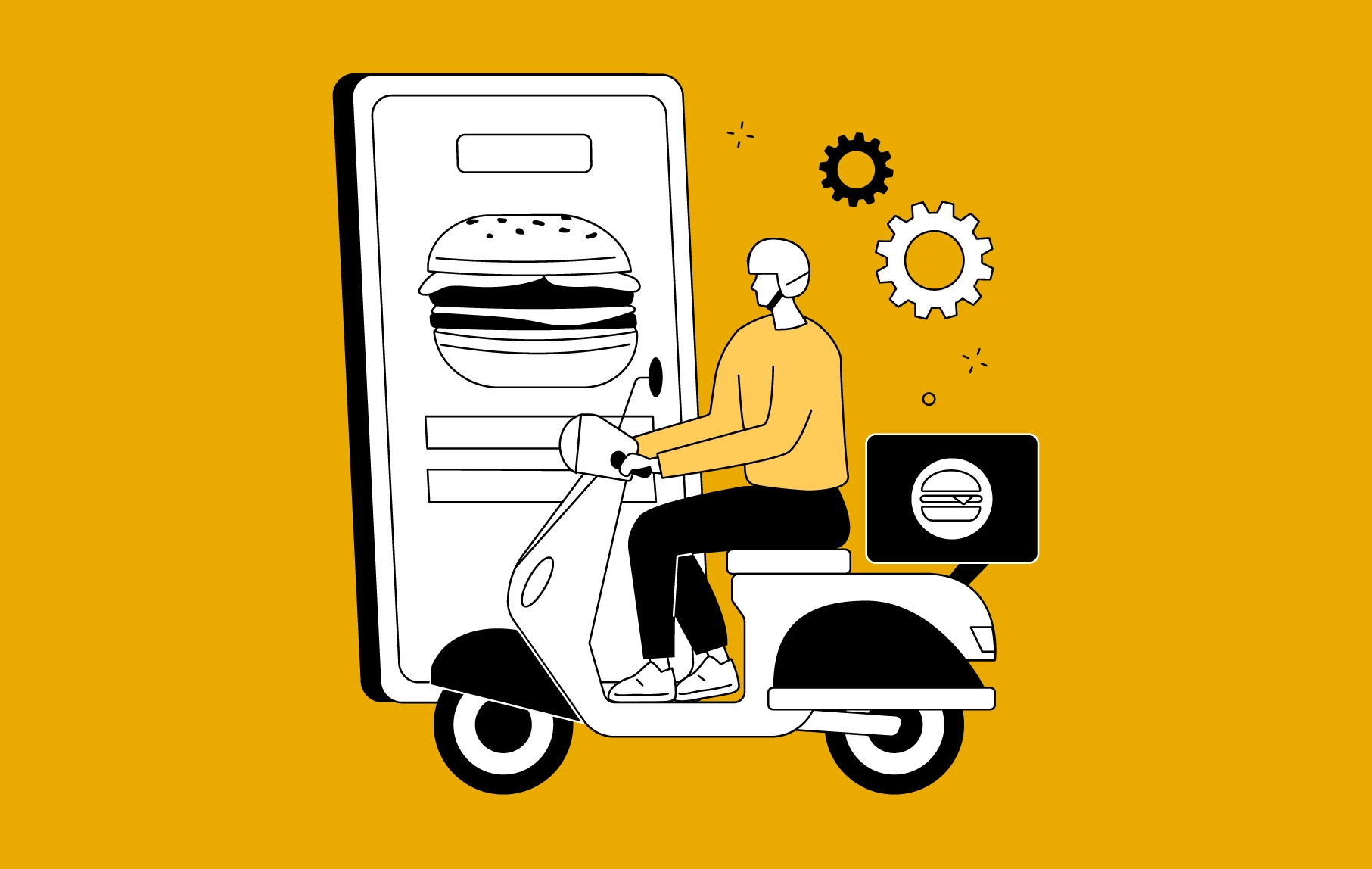
How Much Does It Cost to Develop a Food Delivery App like Glovo?
Food delivery businesses have progressively increased in the last few years, assisting companies in augmenting operational efficiency by prioritizing customers. Behind the success of food delivery businesses, apps like Glovo play a significant role helping through strategic execution, targeting audiences, and enhancing customer retention. Building a food delivery app like Glovo is a strategic process…

How Much Does It Cost to Build a Translation App Like DeepL?
When it comes to the evolving global digitization, the imperative for effective communication across linguistic borders has become more pronounced than ever. Now, stepping into the forefront of this linguistic evolution is DeepL, a translation app that addresses the need for effective communication across languages in the digital landscape. It stands out by using advanced…











